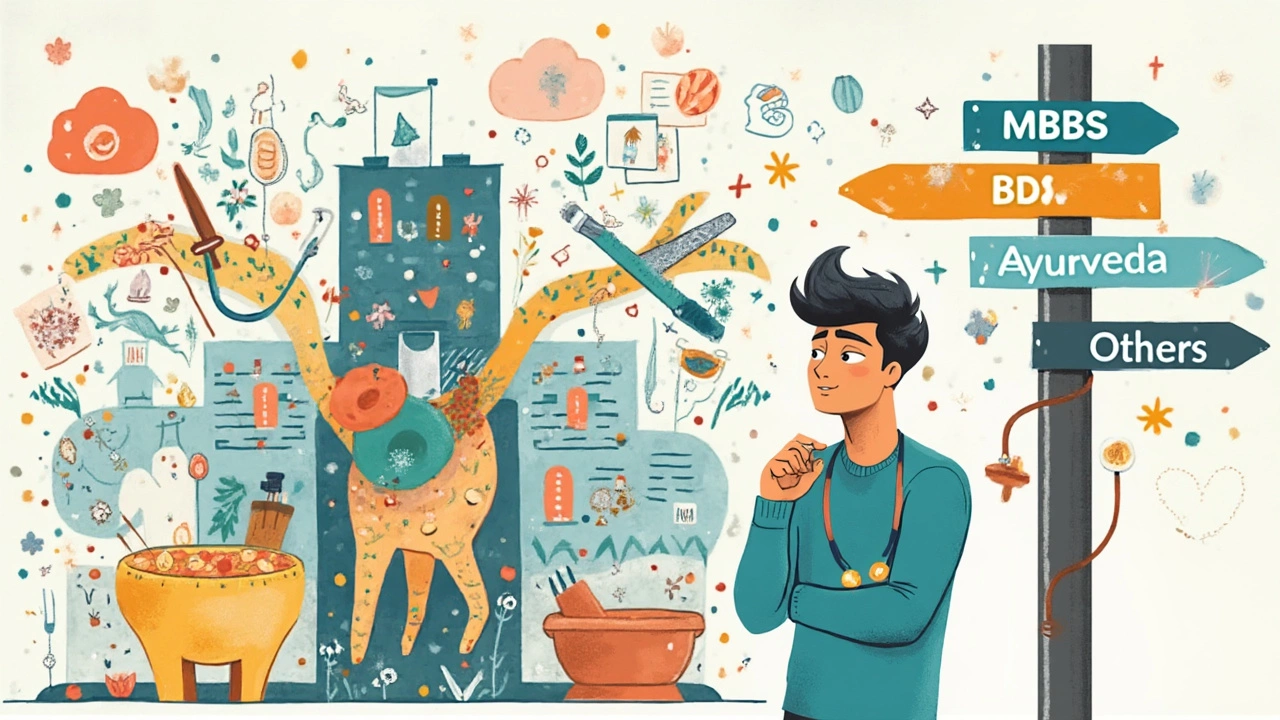Which Doctor Is Best After NEET? Your Smart Options Explained
 Apr, 24 2025
Apr, 24 2025
So, you’ve cleared NEET or you’re pretty close to the results. Now the real brain-twister kicks in—what kind of doctor should you become? Everyone’s heard of MBBS and BDS, but there’s so much more going on behind those letters. Trust me, just chasing the “best” title isn’t always the smartest move.
Here’s something you might not know: every year, over 20 lakh students show up for NEET. Less than 10% grab an MBBS seat. Yet, MBBS isn’t everyone’s dream, and those who land there often get stuck without a plan for what comes next. And let’s be honest, being a successful doctor isn’t about just passing NEET. It’s about figuring out the branch that fits you, offers real growth, and keeps you sane.
What if your NEET rank isn’t enough for a government MBBS seat? Or suppose you realize dentistry or Ayurveda might match your interest more? It’s not game over—far from it. Choosing your path isn’t just about your marks. Your likes, stamina, and future goals count for more than anyone tells you in school.
If you’re hunting for the ‘best’ doctor after NEET—whether that’s in allopathy, dental, Ayurveda, or even alternative medicine—let’s break down the facts, go beyond the obvious, and help you choose a career that makes sense for real life, not just social media likes.
- What Your NEET Rank Really Means
- Popular Medical Courses: MBBS, BDS, and More
- How to Pick the Right Medical Branch
- Life After MBBS: What’s Next?
- Tips to Make the Best Choice
What Your NEET Rank Really Means
When your NEET results hit your inbox, the first thing you look for is that rank. But what does it really decide for you? Honestly, your rank opens some doors and closes others, but it doesn’t decide your whole future. Let’s break it down.
India has about 1 lakh MBBS seats and nearly 27,000 BDS seats. There are lakhs of NEET aspirants. So if your rank is in the top 10,000, you’re in a good spot for a government MBBS seat. Still, even folks with ranks up to 25,000 sometimes make it, depending on reservations and the state quota system.
| NEET Rank Range | What You Can Get |
|---|---|
| 1 - 10,000 | Top government MBBS colleges, AIIMS, JIPMER |
| 10,001 - 25,000 | Decent government MBBS or top BDS, some state quota MBBS seats |
| 25,001 - 50,000 | Private MBBS colleges (high fees), good private BDS, other courses like BAMS, BHMS |
| 50,001 and above | Private BDS, BAMS, BHMS, nursing, and allied medical courses |
Don’t let a rank lower than you expected freak you out. State quotas, reservation categories, and management quotas mix things up a lot. For example, being from a reserved category can boost your chances at a good seat—even if your rank isn’t in the ‘killer’ range.
If you’re aiming for a government seat, keep track of state-wise cut-offs—these move every year, and some states have surprisingly lower closing ranks for MBBS or BDS thanks to fewer applicants or more seats. Sometimes, walking in with last year’s cutoff info gives you a legit edge.
Remember, your NEET score can also get you a place in BAMS (Ayurveda), BHMS (Homeopathy), BUMS (Unani), and even veterinary science, not just MBBS or BDS. Some of these have solid career prospects and work-life balance, which matters way more than people think.
No matter what, don’t fall for the myth that a lower NEET rank ends your dreams. It just means you might need to look at more options—or be open to new branches. It’s still your turn to drive this journey.
Popular Medical Courses: MBBS, BDS, and More
Once your NEET results are out, the most talked-about option is MBBS. Everybody knows it’s the ticket to becoming an allopathic doctor. But only about 1 in 16 who appear for NEET make it to an MBBS seat, at least in government colleges. Private colleges are a different deal, often costing over ₹50 lakh for the full course. Here’s the kicker: MBBS still leads to tough competition for postgrad seats, and only a fraction make it directly into good specialties like surgery or radiology.
BDS comes next in line. Dentistry isn’t everyone’s first choice, and seats often remain after MBBS gets picked clean. But don’t write it off—running a successful dental clinic (yes, even in small towns) can pay well and the course doesn’t involve as many emergency calls or night shifts. Plus, the journey ends quicker than MBBS, getting you into the job market faster.
There’s also BAMS (Ayurveda), BHMS (Homeopathy), and a range of allied medical courses. BAMS is surprisingly popular these days, especially if you’re open to working in holistic health setups, wellness resorts, or even government jobs. Ayurveda is big in Kerala and growing in metro cities thanks to wellness trends. BHMS may suit those keen on alternative medicine, but it doesn’t have as many high-earning roles compared to MBBS or BDS.
If your NEET score isn’t enough for MBBS or BDS, these options below are worth a look:
- BPT (Bachelor of Physiotherapy): In demand in hospitals, sports teams, and rehab centers.
- B.Sc Nursing: Government and private hospitals are always hiring nurses. International opportunities too.
- Paramedical courses: These include medical lab technology, radiology, and operation theatre tech. Quick job placement and less competition than MBBS.
Here’s a quick snapshot of seat numbers in India (2024 data):
| Course | Govt. Seats | Total Seats | Avg. Course Duration |
|---|---|---|---|
| MBBS | 55,000+ | 1,07,000+ | 5.5 years |
| BDS | 3,900+ | 27,000+ | 5 years |
| BAMS | 4,000+ | 52,000+ | 5.5 years |
Bottom line? Choose the course that actually matches your interests, not just what everyone expects. Each branch is tough in its own way, but all can lead to a successful and satisfying career if you stick with your strengths.

How to Pick the Right Medical Branch
Everyone wants to pick the right branch after NEET, but nobody tells you there’s no single “best” path for everyone. The smart move? Think about three things: your rank, your interest, and what life will really look like in the field you choose.
First, your NEET score matters—a lot. Top ranks usually go for MBBS in government colleges. But there are solid options if you just miss the cutoff. Streams like BDS (dentistry), BAMS (Ayurveda), BHMS (Homeopathy), or BPT (Physiotherapy) can all lead to respected careers.
You want a clear idea of what you’re signing up for? Here’s some real talk:
- MBBS: The classic route, but it’s 5.5 years of hard slog. Post-grad is almost a must if you want the best jobs or private practice.
- BDS: Dentistry takes 5 years and specializes sooner. The patient load is different, and if you’re squeamish about major surgeries but like medical care, it’s a good match.
- BAMS: Ayurveda is getting bigger thanks to a push for traditional medicine. It’s less cut-throat, but keep in mind, not every hospital hires BAMS grads.
- BPT/BHMS: Good for those keen on specific therapies or homeopathy. Demand depends a lot on your location and networking.
One thing most folks don’t realize: there’s a world beyond “doctor” tags. If you’re great at bio, but don’t want a hospital life, courses like B.Sc. Nursing, Paramedical, or even Biotechnology can pay well and give you a less stressful routine.
| Course | Duration | Job Prospects |
|---|---|---|
| MBBS | 5.5 years | High (after PG) |
| BDS | 5 years | Moderate-High |
| BAMS | 5.5 years | Moderate |
| BPT | 4.5 years | Moderate |
| B.Sc. Nursing | 4 years | High (especially abroad) |
Ask around! Talk to real students or doctors in these courses. Watch a few honest YouTube day-in-the-life videos, or call up college seniors. The best decision-makers do their own research—don’t just go by what relatives or neighbors say.
Finally, don’t pick a branch just for the “doctor” label. If you see yourself excited walking into hospitals, MBBS may click. But if you love working with your hands, BDS or BPT could be more satisfying. Think about your future work-life balance, earning goals, and where you want to see yourself in 10 years. This is your roadmap, not anyone else’s.
Life After MBBS: What’s Next?
Clearing NEET and finishing your MBBS isn’t the end of the line – it’s actually just the beginning. So, now what can you do with that degree in your hand?
The most popular move after MBBS is PG (post-graduation) studies. And let’s be real, the competition for MD/MS seats is just as cutthroat as NEET itself. Around 1.8 lakh doctors fight for about 45,000 PG seats every year. That’s just one seat for every four aspirants! If you want to specialize—think cardiology, pediatrics, radiology—you’ll need a top rank in the NEET-PG exam or try options like INI CET
Not a fan of more study? No problem. Here’s what else is on your table after MBBS:
- General Physician: You can open your own clinic or join a hospital. Many doctors start like this, though income grows slowly at first. Building a reputation takes time.
- Government sector: You can crack exams like UPSC CMS (Combined Medical Services) to land stable jobs with perks in government hospitals, railways, or public health services.
- Research & Teaching: Love academics? You can get into research projects, clinical trials, or teaching roles in medical colleges. It doesn’t pay like private clinics but can lead to global opportunities.
- Non-clinical jobs: Think medical writing, health insurance, hospital management, public health, or jobs in pharma companies—these don’t need a specialist degree but still use your MBBS background.
And here’s a quick peek at what doctors often do after MBBS in India:
| Path After MBBS | Typical Time Investment | Notes |
|---|---|---|
| MD/MS (Specialization) | 3 years | Highly competitive, higher earnings |
| Clinical Practice | Immediate start | Slow career growth, reputation matters |
| UPSC CMS / Govt Jobs | 6-12 months (preparation) | Good for job security and work-life balance |
| Teaching/Research | Varies | Options to work in India or abroad |
| Non-clinical Roles (e.g. Medico-Legal, Pharma) | Immediate start | Booming sector for MBBS grads |
Just remember, there’s no single “best doctor” path after NEET. Some folks find their calling as general practitioners, others fall in love with a specialty, and quite a few thrive in hospital management or the pharma industry. Your personality, patience, and lifestyle goals matter as much as your NEET score.

Tips to Make the Best Choice
If you’re scratching your head about which medical path is really the best after NEET, you’re not alone. Making this decision isn’t just about choosing what sounds fancy—it’s about what works for you in the long run.
- Start with Your NEET Rank: If your rank lands you a government MBBS seat, awesome—grab it! If not, don’t panic. Plenty of career after NEET options exist: BDS, BAMS, BHMS, and even paramedical courses.
- Check the Competition by the Numbers: Last year, less than 8% of NEET aspirants got an MBBS seat. About 25,000 seats went to dental (BDS) and 60,000+ to alternate medicine like Ayurveda and Homeopathy. So, know your odds and don’t shy away from solid alternatives.
- Know Your Real Interest: Talk to real doctors and students—find out what a day, month, or year in each branch actually looks like. You might find you’re more passionate about Ayurveda, surgery, or even radiology.
- Look at Course Duration and Future Scope: MBBS takes 5.5 years (internship included); BDS and BAMS take about 5 years. The pay, work-life balance, and job options vary a lot after graduation. Check job placement stats online—some state universities put these numbers on their sites.
- Consider Cost and Location: Government colleges cost a fraction of private ones, and scholarships can make a difference. Don’t ignore travel or living costs.
- Backup with Research: Use official NEET and Ministry of Health portals for the latest cut-offs, seat counts, and career info. There’s too much fake news out there.
| Course | Seats Available | Avg Govt Fees (INR/yr) | Avg Pvt Fees (INR/yr) |
|---|---|---|---|
| MBBS | 1,07,000 | 50,000–1,75,000 | 10–25 lakh |
| BDS | 27,868 | 20,000–90,000 | 2–6 lakh |
| BAMS | 52,720 | 25,000–1,50,000 | 2–4 lakh |
If you’re still confused, try making a short list of branches that excite you and match your practical needs. Don’t just go for medical specializations with the highest pay or “social status”—those things won’t matter if you’re not happy with your day-to-day life.
One last thing—keep chatting with seniors and working pros. A five-minute conversation with someone actually doing the job could save you years of regret. The ‘best’ doctor after NEET is the one whose journey fits you best—not what the neighbor auntie thinks is cool.